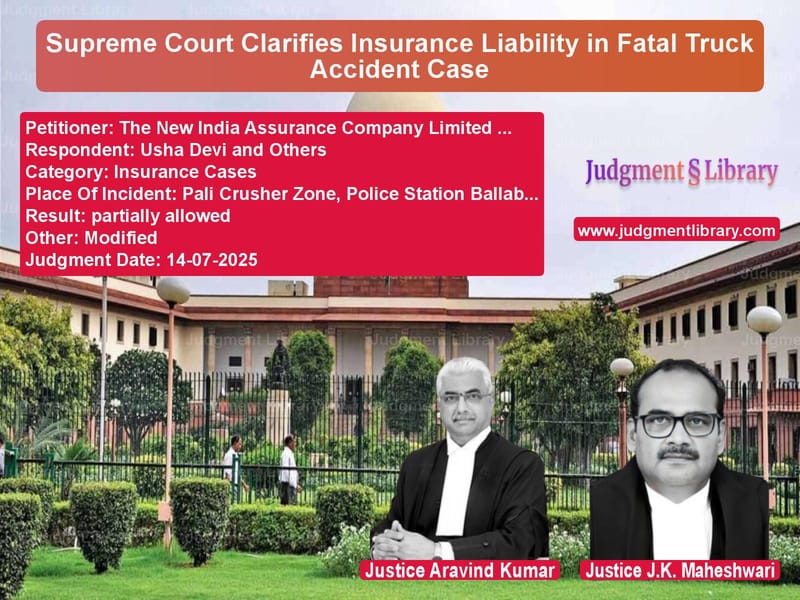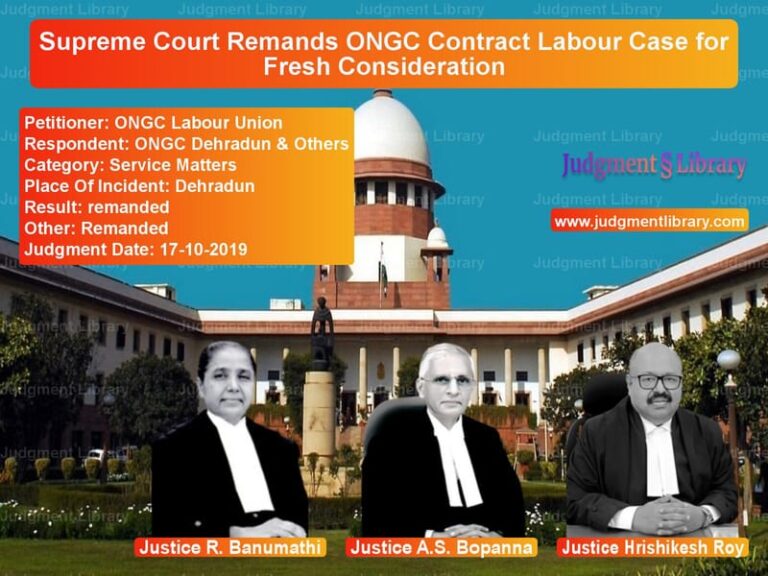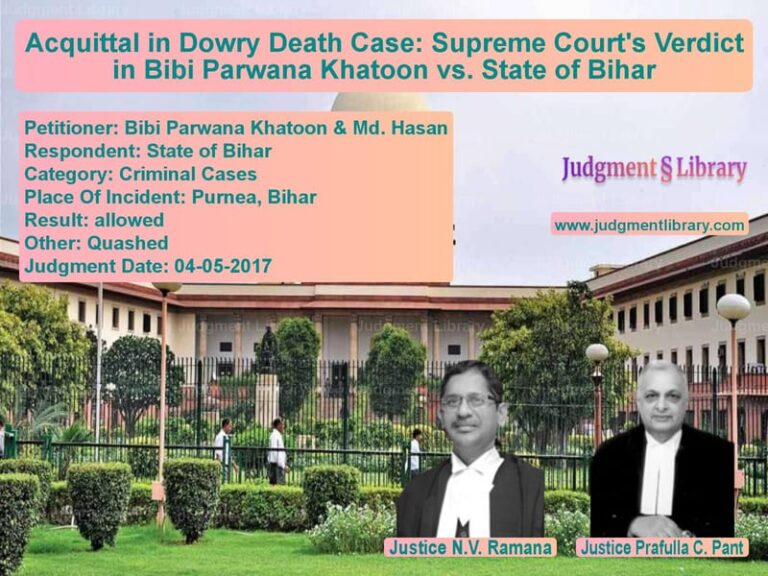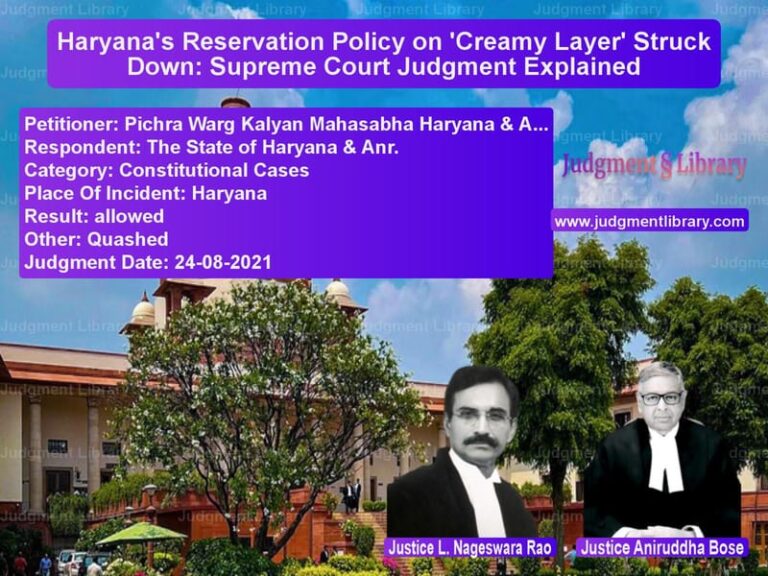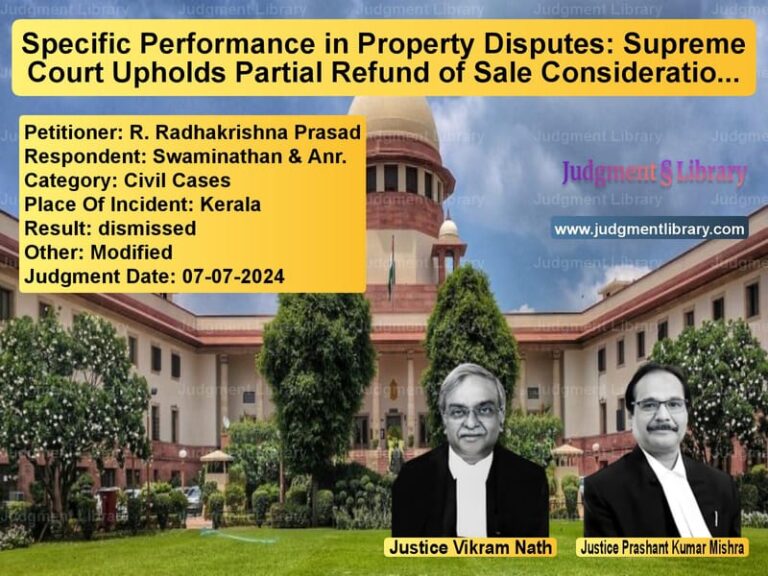Supreme Court Clarifies Insurance Liability in Fatal Truck Accident Case
In a landmark judgment that clarifies several important aspects of motor accident claims, the Supreme Court recently delivered a verdict in a tragic case involving the death of a truck driver in a collision between two vehicles. The case, which had been winding through the legal system for nearly two decades, finally reached resolution with important implications for insurance companies, accident victims, and their families.
The unfortunate incident occurred on the night of November 15, 2006, in the Pali Crusher Zone area. Mr. Surender Singh was driving his truck when it collided with a dumper vehicle. The impact was severe, and though Mr. Singh was rushed to GTB Hospital in Delhi, he succumbed to his injuries on November 22, 2006. He left behind a grieving family – his wife Usha Devi, four children, and his aged mother, all dependent on his income as a truck driver.
An FIR was registered against the dumper driver under sections 279/337/304-A of the Indian Penal Code at Police Station Ballabgarh. The family filed a claim petition under Section 163A of the Motor Vehicles Act, 1988, seeking compensation of Rs. 15,00,000, alleging that the dumper driver, Mr. Islam, was driving rashly and negligently when the accident occurred.
The Legal Journey Through Lower Courts
The case first went to the Motor Accidents Claims Tribunal in Faridabad, which dismissed the claim petition in 2011. The tribunal held that the claimants had failed to prove that the accident was caused by the rash and negligent driving of Mr. Islam, the dumper driver. Since the tribunal found no negligence proved, it didn’t even proceed to compute the compensation amount.
Dissatisfied with this outcome, the family appealed to the Punjab & Haryana High Court. In February 2020, the High Court set aside the tribunal’s order and awarded a lump sum compensation of Rs. 15 lakhs with 9% interest. The High Court directed that the compensation should be paid jointly by all respondents and that both insurance companies – New India Assurance Company (insurer of Mr. Singh’s truck) and National Insurance Company (insurer of the dumper) – should initially pay the amount while reserving their rights to recover from the vehicle owners if permissible under their policies.
The Supreme Court Battle
Both insurance companies approached the Supreme Court with separate appeals challenging the High Court’s judgment. Their lawyers presented contrasting arguments about their liability and the compensation calculation.
Mr. Ranjan Kumar Pandey, representing New India Assurance Company, argued that “the compensation awarded to the claimants is exorbitant and against the settled law and hence it ought to be reduced.” He contended that awarding lump sum compensation went against the scheme of Section 163A, which requires compensation to be determined strictly according to the Second Schedule of the Act. He also argued that “no amount can be provided under the heads of loss of ‘love and affection’ and ‘physical/mental pain and agony’, as the same are not provided under Second Schedule of the Act.”
Mr. Ambhoj Kumar Sinha, representing National Insurance Company, took a different approach. He argued that “the deceased was not a third party, hence not covered under the policy.” He contended that “it is settled law that the insurance company cannot be held liable to pay compensation in a case like the present one, in which the victim was the driver himself and he cannot be treated as a third party within the ambit of Section 147 of the Act, because he steps into the shoes of the owner while driving the vehicle.”
On the other side, Mr. V. Elanchezhiyan, representing the claimant family, defended the High Court’s judgment. He argued that the compensation was just, fair, and reasonable, and pointed to the FIR and witness testimony as evidence that the accident resulted from the dumper driver’s negligent driving.
The Supreme Court’s Analysis
The Supreme Court bench comprising Justices Aravind Kumar and J.K. Maheshwari began by addressing a fundamental legal question: whether negligence needs to be proved in claims under Section 163A of the Motor Vehicles Act.
The Court made a crucial observation: “While entertaining a claim petition u/s 163A of the Act, the question of negligence cannot be looked into.” The judges referred to their earlier decision in United India Insurance Company Ltd. V. Sunil Kumar & Anr., noting that “grant of compensation under Section 163-A of the Act on the basis of the structured formula is in nature of a final award and the adjudication thereunder is required to be made without any requirement of any proof of negligence of the driver/owner of the vehicle(s) involved in the accident.”
This finding meant that the tribunal had erred in dismissing the claim based on lack of proof of negligence when the case was filed under Section 163A, which specifically doesn’t require such proof.
Recalculating the Compensation
The Supreme Court then turned to the proper calculation of compensation. While the High Court had awarded a lump sum of Rs. 15 lakhs, the Supreme Court emphasized that under Section 163A, compensation must be calculated strictly according to the Second Schedule of the Motor Vehicles Act.
The Court noted that the deceased was 35 years old with six dependents. Following the Second Schedule, the judges determined the annual income as Rs. 40,000, deducted one-third for personal expenses, and applied a multiplier of 17 based on the deceased’s age. This calculation resulted in Rs. 4,53,339 for loss of income.
Additionally, the Court awarded Rs. 2,000 for loss of consortium, Rs. 5,000 for funeral expenses, Rs. 2,500 for loss of estate, and Rs. 15,000 for medical expenses (as limited by the Second Schedule), bringing the total compensation to Rs. 4,77,839 with 8% interest from the date of the petition.
The Critical Third-Party Question
One of the most significant aspects of the judgment was the Court’s ruling on whether Mr. Singh could be considered a “third party” in relation to the dumper vehicle. National Insurance Company had argued that as the driver of his own truck, he couldn’t be considered a third party for insurance purposes.
The Supreme Court rejected this argument, stating: “In the absence of any positive evidence being placed by the insurer of the offending vehicle to prove the manner in which accident occurred, we are of the considered view that the deceased in the instant case would be a ‘third party’ in so far as offending vehicle (dumper truck bearing No.HR 38H 9100) is concerned.”
This finding meant that National Insurance Company, as the insurer of the dumper, was liable to pay the compensation. The Court exonerated New India Assurance Company from liability and ordered the refund of any amount they had deposited.
Final Disposition and Distribution
The Supreme Court allowed the appeals in part, modifying the compensation amount and fixing liability solely on National Insurance Company. Given that the accident had occurred nearly 20 years earlier, the Court ordered prompt disbursement of the awarded amount to the family members in specified ratios: 50% to the widow Usha Devi, 10% each to the four children, and 10% to the deceased’s mother, with the mother’s share going to the widow if she was no longer alive.
Broader Implications
This judgment serves as an important clarification on several aspects of motor accident claims law. It reinforces that claims under Section 163A don’t require proof of negligence, making it easier for accident victims and their families to receive compensation without lengthy legal battles over fault.
The decision also provides clarity on the “third party” status of drivers involved in accidents with other vehicles. When a driver of one vehicle is injured or killed due to collision with another vehicle, they are considered third parties in relation to the other vehicle for insurance purposes.
Furthermore, the judgment emphasizes that compensation under Section 163A must be calculated strictly according to the Second Schedule, preventing arbitrary lump sum awards that might either shortchange claimants or unfairly burden insurance companies.
For the family of Mr. Surender Singh, the Supreme Court’s judgment brings closure to a nearly two-decade-long legal battle. While the compensation amount was substantially reduced from the High Court’s award, the final resolution provides them with the certainty and finality they needed to move forward with their lives, knowing that justice, though delayed, was ultimately served.
Petitioner Name: The New India Assurance Company Limited and National Insurance Company Limited.Respondent Name: Usha Devi and Others.Judgment By: Justice Aravind Kumar, Justice J.K. Maheshwari.Place Of Incident: Pali Crusher Zone, Police Station Ballabgarh.Judgment Date: 14-07-2025.Result: partially allowed.
Don’t miss out on the full details! Download the complete judgment in PDF format below and gain valuable insights instantly!
Download Judgment: the-new-india-assura-vs-usha-devi-and-others-supreme-court-of-india-judgment-dated-14-07-2025.pdf
Directly Download Judgment: Directly download this Judgment
See all petitions in Motor Insurance Settlements
See all petitions in Third-Party Insurance
See all petitions in Compensation Disputes
See all petitions in Road Accident Cases
See all petitions in Insurance Settlements
See all petitions in Judgment by Aravind Kumar
See all petitions in Judgment by J.K. Maheshwari
See all petitions in partially allowed
See all petitions in Modified
See all petitions in supreme court of India judgments July 2025
See all petitions in 2025 judgments
See all posts in Insurance Cases Category
See all allowed petitions in Insurance Cases Category
See all Dismissed petitions in Insurance Cases Category
See all partially allowed petitions in Insurance Cases Category

